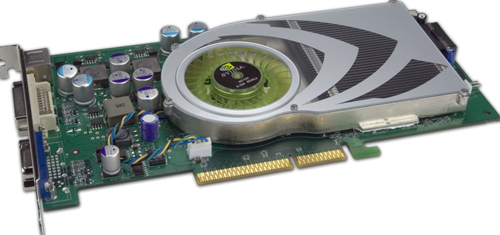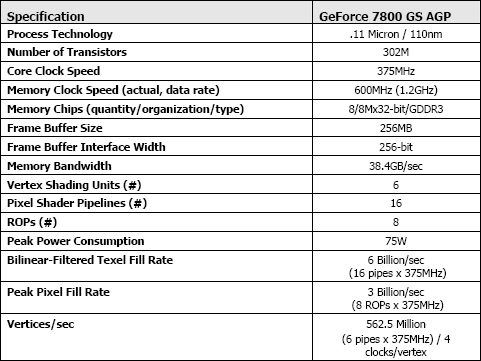The Card and The Test
As mentioned, we currently have both a 7800 GS from EVGA and the 7800 GS OC from BFG. Neither of these cards run at the default 375/1.2 clock speeds set forth by NVIDIA. For the purposes of these tests, we underclocked a card to the minimum speed that NVIDIA is endorsing. With the high clock speeds that we see from BFG and EVGA, we'd be willing to bet that even 7800 GS parts that don't come factory overclocked would have some head room. The EVGA card is clocked at core/mem clocks of 460/1.35, while the BFG part runs at 400/1.25. It is interesting to note that the BFG part makes a bigger deal out of being overclocked on the box than the EVGA card, but either way, the 7800 GS is no slouch.
Gigabyte K8U-939 ULi based motherboard
AMD Athlon 64 FX-57
2x 1GB OCZ PC4000 RAM @ 200MHz 2:3:3:8
160GB Seagate 7200.7 HD
OCZ 600W PowerStream PSU
For reference, we have included the 7800 GTX 512 and the X1900 XTX. This gives us a clear look at the highest end ATI and NVIDIA hardware available for both the AGP and PCIe platforms. The 7800 GT is also included in order to show us the performance of the next fastest NVIDIA part out there.
Here's a breakdown of the 7800 GS specifications as outlined by NVIDIA.
As mentioned, we currently have both a 7800 GS from EVGA and the 7800 GS OC from BFG. Neither of these cards run at the default 375/1.2 clock speeds set forth by NVIDIA. For the purposes of these tests, we underclocked a card to the minimum speed that NVIDIA is endorsing. With the high clock speeds that we see from BFG and EVGA, we'd be willing to bet that even 7800 GS parts that don't come factory overclocked would have some head room. The EVGA card is clocked at core/mem clocks of 460/1.35, while the BFG part runs at 400/1.25. It is interesting to note that the BFG part makes a bigger deal out of being overclocked on the box than the EVGA card, but either way, the 7800 GS is no slouch.


Gigabyte K8U-939 ULi based motherboard
AMD Athlon 64 FX-57
2x 1GB OCZ PC4000 RAM @ 200MHz 2:3:3:8
160GB Seagate 7200.7 HD
OCZ 600W PowerStream PSU
For reference, we have included the 7800 GTX 512 and the X1900 XTX. This gives us a clear look at the highest end ATI and NVIDIA hardware available for both the AGP and PCIe platforms. The 7800 GT is also included in order to show us the performance of the next fastest NVIDIA part out there.
Here's a breakdown of the 7800 GS specifications as outlined by NVIDIA.











93 Comments
View All Comments
Ezza - Saturday, February 4, 2006 - link
This article needs to be taken with a grain of salt since the 7800GS in the article is a PCI-E engineering sample. In this article the 7800GS scales very well when overclocked, hopefully the AGP version will show similar gains when overclocked.Stas - Thursday, February 2, 2006 - link
I have x800 Pro o/c. I really want to upgrade but buying a new mobo + video card is a bit too expansive. If only I could get a better video on the level with 7800GT and x1800XL, I would be happy. Unfortunatelly, 7800GS just doesn't cut it (you've seen the tests). I wish they come out with AGP versions of 1800XL and 7800GT, I would have gotten one. But then again, ATi and nVidia both make chipset with PIC-E, thus it is profitable for them to have people buy new mobos with PCI-E. :(NullSubroutine - Thursday, February 2, 2006 - link
it seems rediculous to me that with an agp part, you compared...not other AGP parts, but high end pci-express cards. i have an agp system, i want to know how much better it is than other AGP cards out there, not a top of the line card, that would require me to upgrade my processor and mainboard.again, you have done so in the past, so i request it once again. many people buying this product run either 10x7 or 12x10 with and without 4x 8x. these were left out in the line graphs, i request them once again. otherwise without both these things, i think it leaves us people who would considering to buy this product, needing to go elsewhere to find out how it compares, and what is a good buy.
mindless1 - Thursday, February 2, 2006 - link
Agreed. Not everyone is as interested in how a card does at all kinds of maxxed out settings and features as we are at what measures would be needed to use the card for modern games, playable rates. If a feature entails a significant performance penalty, but one has an AGP board, of course they'd disable the feature when necessary.I also fail to see the logic in lowering card clock speeds when (all) 2 samples were shipped at a higher rate. While one may not want to manually raise the speeds for the tests, the out-of-box speed a card uses should be considered stock no matter what nVidia spec'd. IOW, I don't see a lot of people underclocking their cards, it would be a scenario never seen in gaming use, IMO.
coldpower27 - Thursday, February 2, 2006 - link
X850 XT non PE
6800 GS (AGP)
6800 GS (PCI-E)
EVGA 7800 GS at it's factory OC Settings.
6800 Ultra
6800 GT
coldpower27 - Thursday, February 2, 2006 - link
In addition to the aboe now that I think of it I would like these 2 to be included as well.6800 AGP
6600 GT AGP
DerekWilson - Thursday, February 2, 2006 - link
Thanks for the suggestions, we will certainly consider including these cards in future AGP performance comparisons.Thanks,
Derek Wilson
Boushh - Thursday, February 2, 2006 - link
I agree with others that you should have picked other cards for a comparison. Specialy considering your introduction words in the article.The point is that it's about users who still use up-to-date AGP systems (like me) that would like to know if this card is worth the money and wait a little longer to upgrade to PCIe.
Therefore the comparison should have been between this card and other AGP cards at the same price point, or more expensive ones. Now you only tested the X850. A card that most people reading the test will probaly not even consider as an upgrade. And comparing it to the X1900XTX and 7800 GTX 512 Mb ? Come on ! Like these cards would be viable upgrades considered by the people who are intrested in this card..
Besides, if I want PCIe numbers I can read any of your other tests.
There are also no noise, power consumption, and OC results (I bet the eVGA would beat the X850 hands down). And the test was done on a medicore ULi based board instead of a high-end S939 board.
Sorry for the harsch comment, but I simply had to say this ;-)
MrKaz - Friday, February 3, 2006 - link
80% agree.You only failed on one post.
"And the test was done on a medicore ULi based board instead of a high-end S939 board."
You forget that there arent no longer high eng AGP systems.
The existing ones are "outdated".
bob661 - Thursday, February 2, 2006 - link
Isn't this an oxymoron?